- Home
- Troubleshooting
- Computer Tool Kit
Your Computer Tool Kit Introduction
Stephen Harrison B.Sc. (Hons), M.Sc., MBCS, CITP
A sensible computer tool kit is a must if you are serious about fixing your hardware issues. Many types of tools are available, but which ones are a must? Which ones are appropriate for certain types of devices?
In this series, we look at some of these tools in detail, such as the preferences for kit bags or kit boxes, and the myriad of different screwdrivers that you need access to. We also consider why some of them get incorrectly overlooked even by seasoned professionals.
I also tell you what hardware I have in my computer tool kit. Through trial and error, this is the equipment I have come to rely on when fixing computers.
The best tools for the job, however, are things you already own; your hands, eyes, ears and brain! Coupled with a tried and tested approach to troubleshooting, you are already on your way to becoming an excellent computer problem solver.
Keep up with the latest news and developments
Sign up to the eComputerZ Newsletter
The free A to Z of performing BIOS updates guide that anyone can follow.
✔ A checklist of important actions to perform throughout the update process.
✔ Further supporting information to aid your update plans.
✔ My unique approach for sourcing the latest BIOS versions for any motherboard manufacturer.
Sign up below for instant access to the guide, or by going to the Subscription page for more details.
I never share information with third parties and your details are secure.
I aim to issue newsletters at the start of each month.
Contents
Computer Tool Kit Bag or Box?
Before thinking about tools, accessories and testing devices in detail, we first consider how to store and transport your equipment. An online search brings back numerous options. However, there are really two choices, and that is a computer tool kit bag and toolbox.
Toolboxes
Toolboxes are the least popular of the two options. They are more suitable to Do-It-Yourself (DIY) jobs than fixing computers.
Toolboxes come with secure compartments and drawers for small items such as screws, motherboard batteries and RAM sticks, and larger storage spaces for cables and hard drives.
They are also made from sturdy plastic, durable and have a decent handle to carry about.
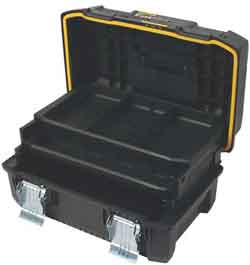 Computer Tool Kit Box
Computer Tool Kit BoxHowever, I find over time equipment gets mixed up and sometimes damaged. This is due to the limitations of the drawers and compartments (not enough and often too small).
However, this could be down to general disorganization on my part, especially after working on several machines in a short space of time.
For example, a RAM stick ends up at the bottom of the box underneath a hard drive and other items, and the weight ultimately causes damage to the component. This is often unnoticeable until you come to use it, which is frustrating and costly!
Always try your best to be organized, and have a tidy up from time to time. It saves you a lot of time and effort, especially when working on machines, and prevents accidental damage to your support tools.
Computer testing equipment and internal hardware components are sensitive and can break easily. For this reason alone, toolboxes like this are generally unsuitable, in my opinion, as a means for storing and transporting your computer repair equipment.
Kit Bags
Kit bags are much more functional than toolboxes. They tend to be made from waterproof fabric and come with multiple pockets (50+ in some instances), some with elasticized tool holding loops, to organize your tools properly.
No more rummaging around for your equipment any more!
Fold out panels and external pockets enable you to manage your frequently used equipment or components for easy access, and some kit bags include document pouches or pockets that protect your paperwork.
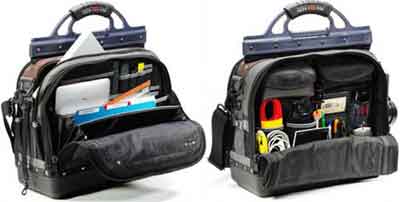 Computer Kit Bag
Computer Kit BagThere is protected space in the middle for your Laptop too. Bag design options range from standard handle and should strap types, to ruck-sack types which are more suitable for those with back issues.
Of course, kit bags are prone to wear and tear, therefore the make and type of bag you need is important.
For example, if you are working in extreme environments such as an oil rig or a manufacturer's shop floor, a more sturdy bag with strong fabric, increase laptop protection and strengthened pockets is a must.
Now that you have your kit bag, or have an idea of what your options are, we look next at some basic but significant tools all home and professional IT technicians require, which is screwdrivers.
Return to the Table of Contents
Screwdrivers
You cannot perform any computer support maintenance tasks without screwdrivers. They are a staple part of your kit bag. There are various types of screws, and screwdrivers to use them. Some screwdrivers come with fixed heads, others come with swappable heads.
The most common type used for computer cases and fixing internal expansion cards to the motherboard is the Phillips head screwdriver/screw.
The head of the screw is designed in an X or cross shape for extra torque which makes them easier to rotate and loosen or tighten. The image below shows the common types of screws and screwdrivers.
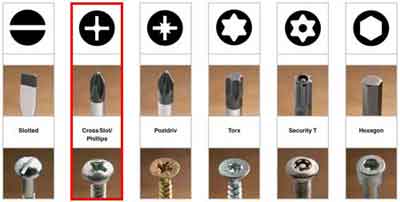 Screwdriver Types With Examples
Screwdriver Types With ExamplesSource:- www.diybyexample.info
Make sure you have a quality set of Phillips screwdrivers in your computer tool kit! Many modern computers use Phillips screws. The more machines you investigate and fix, the more often your (Phillips) screwdrivers are in use.
Aim to have a variety of different sizes and lengths of screwdriver at your disposal. Screw size can vary from machine to machine.
The longer the screwdriver, the easier it is to loosen the tighter screws (yes, there's always one that's threaded or much tighter than all the others!). They are also useful for those hard to reach places too.
A ratchet screwdriver enables you to reposition your hand for another turn (whether tightening or loosening a screw) without having to remove the screwdriver head from the screw itself. Simply turn your wrist (anti-) clockwise.
When you use a non-ratchet screwdriver, the pressure on the screw head to make the next turn is relaxed (or the screwdriver head is temporarily removed from the screw). This is what often causes screws to fall out of their holes when you first try to tighten them.
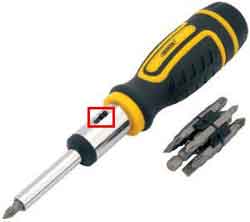 Ratchet Screwdriver
Ratchet ScrewdriverThere are three manuals setting for the ratchet screwdriver.
- Clockwise;
- Anti-Clockwise;
- Normal Mode, i.e. Behaves like a standard/normal screwdriver.
Ratchet screwdrivers are a popular choice among IT technicians to have in their computer tool kit. They often come with space in the top of the handle to keep screws in for easy access.
Some people prefer to use battery or power operated screwdrivers, especially if suffering from Repetitive Strain Injury (RSI). However, I would strongly advise against this when working on IT equipment.
It can be difficult to gauge what is too tight, and therefore causing damage to your internal computer hardware components.
Computer manufacturers advise against using magnetic screwdrivers. I must admit they are very useful, especially when working in tight spaces. It is frustrating when you drop a screw inside a computer case. It is often difficult to retrieve.
If you are going to use a magnetic screwdriver, please use with caution. Make sure you do not touch any of the internal components, even though it is unlikely to cause any serious damage. Better to be safe than sorry.
Some computer manufacturers prefer Torx screws. These tend to have six sides (star shaped) instead of the four sides you get with Phillips screws.
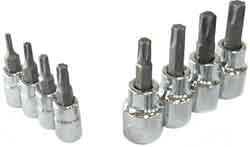 Computer Tool Kit
Computer Tool KitTORX Screwdriver Heads
In theory, six sides gives more torque than four sides. However, I often find some screw and screwdriver heads wear down after multiple use. When this happens a slotted or flat head screwdriver typically works to remove the screw.
At this stage, it is likely the screw or screw head needs to be replaced with a new one.
There are varying sizes of Torx screwdrivers. It is always best to have a variety of sizes. T5 to T7 are typically used in Laptops. T8 to T10 are typically used in desktop computers.
Next we briefly look at some other types of tools to keep in your computer tool kit.
Return to the Table of Contents
Other Essential Support Tools
The tools highlighted below have pride of place in my computer tool kit. I use them much more than I originally anticipated.
Needle Nose Pliers
As mentioned previously, small chassis crews fall into every nook and cranny, and can be a night mare to retrieve. Using a magnetic screwdriver helps, but is not always ideal. What about non-metallic items such as jumpers or Molex cover (both plastic/non-metallic)?
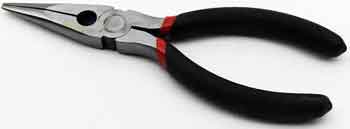 Needle Nose Pliers
Needle Nose PliersNeedle nose pliers have a long, thin 'beak' that give you access to the variety of places your fingers, and even your magnetic screwdriver, cannot reach.
Ensure the mechanism remains lubricated as they can stiffen up which makes practical use a nightmare.
Do not touch any electrical circuits for your safety, and integrity of your hardware components. See the PC Repair Tools article for information on how to manage ElectroStatic Discharge (ESD).
Cutters
Your cutter must be sharp! Working inside computers presents a whole host of challenges.
For example, I've come across a number of cables strapped together and to the chassis, with cable ties! Whilst this brings order and tidiness to the inside of your computer, it presents a potential nightmare to the technician.
There are also scenarios where you need to use a spare power cable connected to the PSU, and this is also tied to such an extent that it does not reach the new component you are connecting to.
New cables can also come with other types of sturdy, plastic ties that only a knife like blade can cut through.
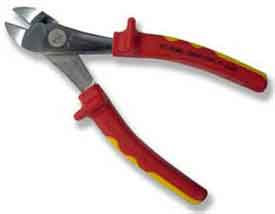 Cutter
CutterThe handles and the curved parts on the outside of the blade provide greater control when cutting cable ties or straps. You manoeuvre the cutter into position using the curve of the blade, then use the handles to execute a clean cut without damaging the wires.
Using a knife or other type of blade is not advisable. You want to avoid injuring yourself in the process.
Using a knife or other type of blade to cut through cable ties is not advisable! You want to avoid injuring yourself and damaging wiring in the process.
If I had my way, I would use Velcro ties in all possible scenarios. They do the dame job as cable ties and are much easier and quicker to manage!
Label Scraper
A scraper in a computer tool kit? Although surprising, this is a tool that comes in handy time and time again. It takes care of those hard to remove stickers, and helps to remove thermal paste from CPU heat sinks (although a lint free cloth with isopropyl alcohol is often better).
 Label Scraper
Label ScraperThe blades are very thin, which allow you to remove stickers cleanly and without damaging the components. The usual cautions of blades and computer components apply.
Pen Torch
A pen torch is a great addition to your computer tool kit. No surprise to hear they provide light when you need it.
Take care when choosing your pen torch. There are many makes and models available. Try to find one that is easy to use and where the bulb and batteries are replaceable. Some pen torches are disposable.
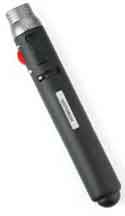 Pen Torch
Pen TorchTry before you buy! The amount and type of light is important to suit your needs. I tend to go for those with white light or LED bulbs. Make sure it is easy to switch on and off. The pen torch I am currently using is the Ledlenser P2.
Paper Clip
A paper clip is an absolute must for your computer tool kit! That's right, a paper clip! Not a special IT professional paper clip - a standard, every day paper clip, like this one.
 Paper Clip
Paper ClipThe main reason for including paper clips in your computer tool kit is to dislodge CD's or DVD's from their drives.
Look closely at yours and there is a small hole near the eject button or volume control. Unravel your paper clip and insert one of the ends into the hole. This moves internal cogs and opens the tray enough to remove the media.
The most common reason I do this for is when the DVD is not seated correctly and the DVD player drawer is closed or closes automatically. However, it is worth noting that DVD players are becoming legacy devices in the days of USB sticks and cloud computing.
Some components have a reset button that resides in a small hole to prevent accidental activation. Use your paper clip to activate if required. This is useful if you have an item that is locked out, and you need to perform a factory reset.
Return to the Table of Contents
Computer Tool Kit | Final Thoughts
Computer tool kits grow and evolve. Items get used. They break. New items with more modern capabilities and additional items you did not need until now are acquired. You also find through doing what works for you and what doesn't.
The list of items here work fine for me, but may not for you. However, you need to start somewhere. Another option is to simply buy a general computer screwdriver kit.
A disadvantage of doing this, however, is you end up with many items you never use, or so you think!
As an example take a look at this general computer maintenance kit to give you an idea of what is available.
Also take a look at this succinct article about computer tool kits for further information.
Finally, the video below is an excellent, easy to understand, walk through of various hardware issues and what the causes are. It is 58 minutes long, but well worth a watch. You will learn so much from this video.
Often the issue you are fixing is not hardware related. To ensure you are in a position to fix software issues, there are some exceptional tools and utilities available.
Computer Repair Tool Kit | Hardware Troubleshooting Demonstration Video
- Home
- Troubleshooting
- Computer Tool Kit

